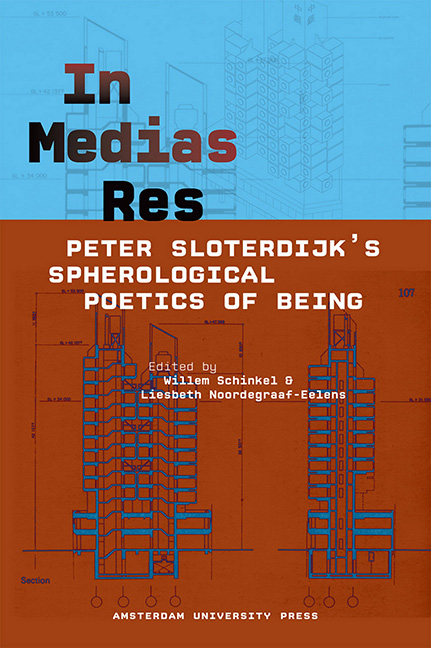Book contents
- Frontmatter
- Contents
- 1 Peter Sloterdijk’s Spherological Acrobatics: An Exercise in Introduction
- 2 Foamy Business: On the Organizational Politics of Atmospheres
- 3 “Transgenous Philosophy”: Post-humanism, Anthropotechnics and the Poetics of Natal Difference
- 4 Disinhibition, Subjectivity and Pride. Or: Guess Who Is Looking?: Peter Sloterdijk’s reconstruction of ‘thymotic’ qualities, psychoanalysis and the question of spectatorship
- 5 Sloterdijk and the Question of an Aesthetic
- 6 Uneasy Places. Monotheism, Christianity, and the Dynamic of the Unlikely in Sloterdijk’s Work – Context and Debate
- 7 The Attention Regime: On Mass Media and the Information Society
- 8 In the Beginning was the Accident: The Crystal Palace as a Cultural Catastrophe and the Emergence of the Cosmic Misfit: A critical approach to Peter Sloterdijk’s Weltinnenraum des Kapitals vs. Fyodor M. Dostoevsky’s Notes from the underground
- 9 A Cautious Prometheus? A Few Steps Toward a Philosophy of Design with Special Attention to Peter Sloterdijk
- 10 Sloterdijk and the Question of Action
- 11 The Space of Global Capitalism and its Imaginary Imperialism: An Interview with Peter Sloterdijk
- Contributors
- Index
5 - Sloterdijk and the Question of an Aesthetic
Published online by Cambridge University Press: 23 June 2021
- Frontmatter
- Contents
- 1 Peter Sloterdijk’s Spherological Acrobatics: An Exercise in Introduction
- 2 Foamy Business: On the Organizational Politics of Atmospheres
- 3 “Transgenous Philosophy”: Post-humanism, Anthropotechnics and the Poetics of Natal Difference
- 4 Disinhibition, Subjectivity and Pride. Or: Guess Who Is Looking?: Peter Sloterdijk’s reconstruction of ‘thymotic’ qualities, psychoanalysis and the question of spectatorship
- 5 Sloterdijk and the Question of an Aesthetic
- 6 Uneasy Places. Monotheism, Christianity, and the Dynamic of the Unlikely in Sloterdijk’s Work – Context and Debate
- 7 The Attention Regime: On Mass Media and the Information Society
- 8 In the Beginning was the Accident: The Crystal Palace as a Cultural Catastrophe and the Emergence of the Cosmic Misfit: A critical approach to Peter Sloterdijk’s Weltinnenraum des Kapitals vs. Fyodor M. Dostoevsky’s Notes from the underground
- 9 A Cautious Prometheus? A Few Steps Toward a Philosophy of Design with Special Attention to Peter Sloterdijk
- 10 Sloterdijk and the Question of Action
- 11 The Space of Global Capitalism and its Imaginary Imperialism: An Interview with Peter Sloterdijk
- Contributors
- Index
Summary
Preliminary remarks
In order to understand Peter Sloterdijk's writings on aesthetics and their singularity, we must first at least outline the “setting”, the historical foil to the problems he addresses. Today, art is a “discourse”, as we know, a conceptual field in which the different types of images, objects, processes, activities, theories, ideas and institutions play a role. The dynamism of this field is characterized by instabilities, contradictions and conflicts that trigger disquiet among the one or other viewer. The one set learns from New Jersey (Land Artist Robert Smithson), the other from Las Vegas (Robert Venturi, Denise Scott Brown). The one camp praizes autonomous formalism and the sublime (Clement Greenberg), the other the transfiguration of the commonplace.
In his writings, J.M. Bernstein demands that aesthetic experience also offer a dimension infused by cognitive theory, ethics and politics. Aesthetic Modernism is the appropriate ethical and political response to capitalist Modernity, which is typified by rationalization, reification and disenchantment. True aesthetic Modernism has to defend radicalism against universal and instrumental claims. He anchors aesthetics in ethics and politics, in a mix of Marx, Lucácz, Kant and Adorno. Over the last two decades, English and American art historians and theorists have seen the need, given the pressure of a global media industry, to expand the analysis of the image culture away from the specific objects of art to all forms of images in our culture, i.e., to include the mass media of film, TV, animated images, etc. The field of art has therefore been extended under the concept of “visual culture”. W.J.T. Mitchell has emphasized that the visual field is constructed socially and the social field visually. Stanley Cavell and Noel Carrall from an early date discussed the mass media of film as a matter of course in light of what Mitchell terms a “pictorial turn”. James Elkins extended Visual Studies (2003) and The Domain of Images (1999) to include the image of the natural sciences.
In Adorno's skeptical Aesthetic Theory (1970) art can still admittedly possess a truth content, but in a purely utopian function. In order to achieve this, art must reflect society and is therefore not fully autonomous. On the other hand, it must be autonomous if it is to adopt a critical function.
- Type
- Chapter
- Information
- In Medias ResPeter Sloterdijk's Spherological Poetics of Being, pp. 83 - 98Publisher: Amsterdam University PressPrint publication year: 2012
- 1
- Cited by



